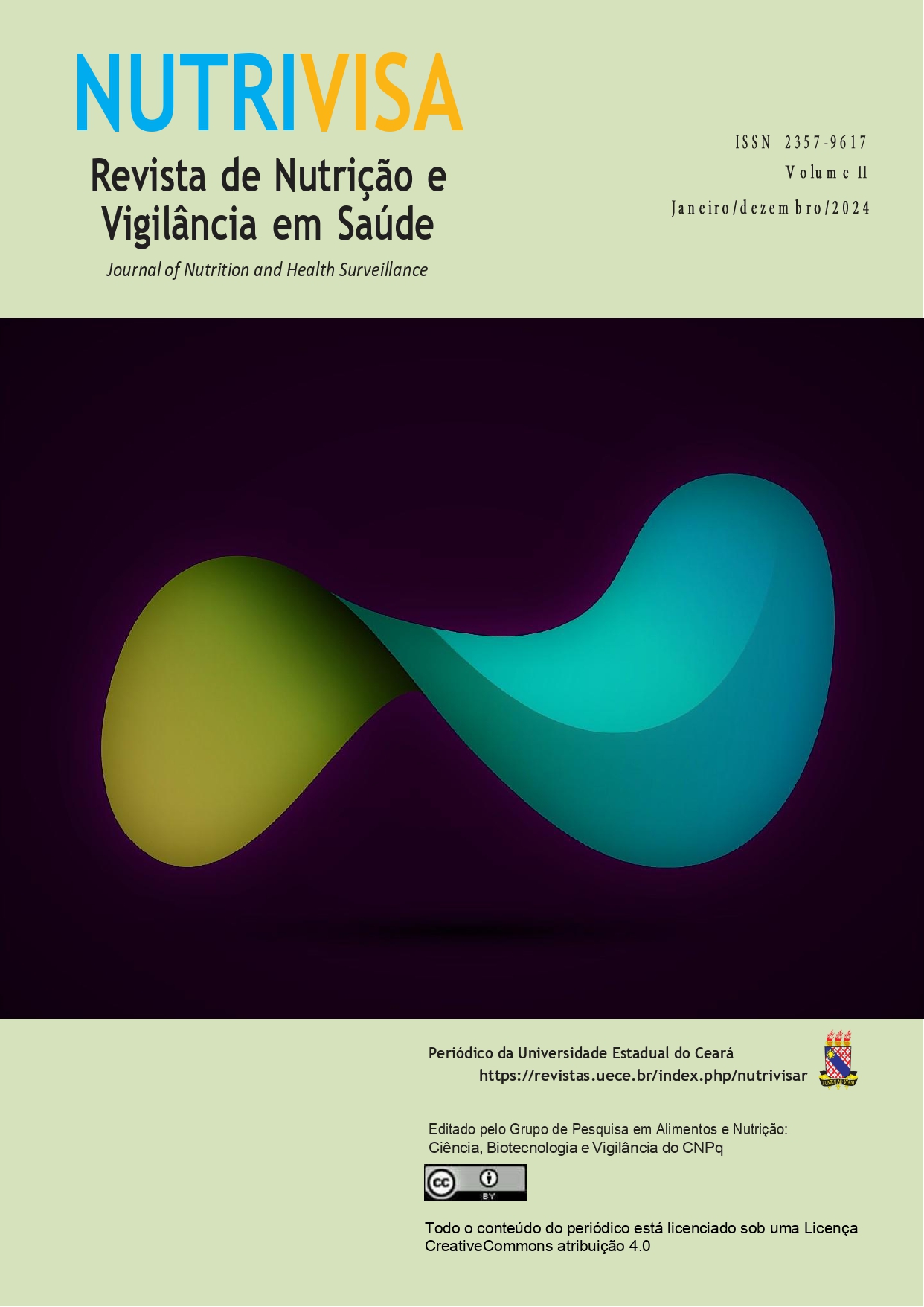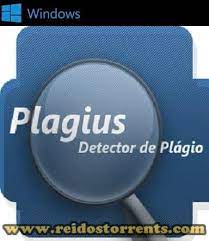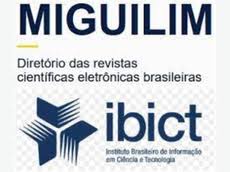Rutin reduces doxorubicin-induced adipose tissue loss and improves antioxidant activity
DOI:
https://doi.org/10.59171/nutrivisa-2024v11e12545Keywords:
Doxorrubicin. Adipose Tissue. Rutin. Redox Imbalance.Abstract
Doxorubicin (DX) is a chemotherapy drug that is widely used by neoplastic patients. However, it promotes deleterious side effects in non-tumor tissues, such as the adipose tissue. The mechanism of action of DX has been associated with greater production of reactive oxygen species, and therapies with antioxidant components, such as rutin, may be beneficial in reducing the adverse effects. Our work aimed at verifying the effect of rutin on adiposity and redox homeostasis of adipose tissue in mice treated with doxorubicin. Male Swiss mice were divided into three groups: control group (CT); doxorubicin (DX) group, that received intraperitoneally 2.5 mg/kg DX hydrochloride, twice a week for 2 weeks; and RT group (DX + rutin), that received, in addition to receiving to DX i.p., 10 mg/kg rutin orally, daily. Food intake and body weight were assessed weekly. Oxidative damage and activity of the antioxidant enzyme catalase were evaluated in the adipose tissue pads (subcutaneous, periepididymal and retroperitoneal). Rutin attenuated the loss of adipose tissue caused by DX, and increased catalase activity. These results demonstrate the importance of further studies to clarify the role of rutin in reducing chemotherapy-related side effects in organs relevant to the control of homeostasis.
References
AKOLKAR, G.; DIAS, D. S.; AYYAPPAN, P.; BAGCHI, A. K.; JASSAL, D. S.; CURY, V. M.; IRIGOYEN, M. C.; DE ANGELIS, K.; SINGAL, P. K. Vitamin C mitigates oxidative/nitrosative stress and inflammation in doxorubicin-induced cardiomyopathy. Am J Physiol Heart Circ Physiol, 1;313(4):H795-H809, 2017. doi: 10.1152/ajpheart.00253.2017.
ALBINI, A.; PENNESI, G.; DONATELLI, F.; CAMMAROTA, R.; DE FLORA, S.; NOONAN, D. M. Cardiotoxicity of anticancer drugs: the need for cardio-oncology and cardio-oncological prevention. J Natl Cancer Inst 102: 14 –25, 2010. doi: 10.1093/jnci/djp440.
AYLA, S.; SECKIN, I.; TANRIVERDI, G.; CENGIZ, M.; ESER, M.; SONER, B. C.; OKTEM, G. Doxorubicin induced nephrotoxicity: protective effect of nicotinamide. Int J Cell Biol, 390238, 2011. doi: 10.1155/2011/390238.
BARBOSA, K. B. F.; COSTA, N. M. B.; ALFENAS, R. D. C. G.; DE PAULA, S. O.;
MINIM, V. P. R.; BRESSAN, J. Oxidative stress: concept, implications and modulating factors. Revista de Nutrição, v. 23, n. 4, p. 629-643, 2010. https://doi.org/10.1590/S1415-52732010000400013.
BING C. Lipid mobilization in cachexia: mechanisms and mediators. Curr Opin Support Palliat Care. 5(4):356-60, 2011. doi: 10.1097/SPC.0b013e32834bde0e.
BIONDO, L.A.; BATATINHA, H.A.; SOUZA, C.O.; TEIXEIRA, A.A.S.; SILVEIRA, L.S.; ALONSO-VALE, M.I.; OYAMA, L.M.; ALVES, M.J.; SEELAENDER, M.; NETO, J.C.R. Metformin Mitigates Fibrosis and Glucose Intolerance Induced by Doxorubicin in Subcutaneous Adipose Tissue. Front Pharmacol. 2018. doi:10.3389/fphar.2018.00452.
BIONDO, L.A.; LIMA JUNIOR, E. A.; SOUZA, C. O.; CRUZ, M. M.; CUNHA, R. D.; ALONSO-VALE, M. I.; OYAMA, L. M.; NASCIMENTO, C. M.; PIMENTEL, G. D.; DOS SANTOS, R. V.; LIRA, F. S.; ROSA, T. O.; NETO, J. C. Impact of Doxorubicin Treatment on the Physiological Functions of White Adipose Tissue. PLoS One. 25;11(3):e0151548, Mar, 2015. https://doi.org/10.1371/journal.pone.0151548.
BRASIL. INCA – Instituto Nacional do Câncer [internet]. Rio de Janeiro: Quimioterapia; 2015 [cited 2019]. Avaliable from: http://www.inca.gov.br/conteudo_view.asp?ID=101.
CABEZA, L.; ORTIZ, R.; ARIAS, J. L.; PRADOS, J.; RUIZ MARTINEZ, M. A.; ENTRENA, J. M.; LUQUE, R.; MELGUIZO, C. Enhanced antitumor activity of doxorubicin in breast cancer through the use of poly(butylcyanoacrylate) nanoparticles. Int J Nanomedicine. 10:1291–306, 2015. doi: 10.2147/IJN.S74378.
CASTILHO, R. O.; KAPLAN, M. A. C. Phytochemical study and antimicrobial activity of Chrysobalanus icaco. Chemistry of Natural Compounds, v. 47, n. 3, p. 436, 2011. DOI:10.1007/s10600-011-9953-x.
GANESHPURKAR, A.; SALUJA A. K. The Pharmacological Potential of Rutin. Saudi Pharmaceutical Journal, 25(2):149-164, 2017. doi: 10.1016/j.jsps.2016.04.025.
GRADINARU, D.; MARGINA, D.; BORSA, C.; IONESCU, C.; ILIE, M.; COSTACHE, M.; DINISCHIOTU, A.; PRADA, G. I. Adiponectin: possible link between metabolic stress and oxidative stress in the elderly. Aging Clin Exp Res., v. 29, n. 4, p. 621-629, 2017. doi: 10.1007/s40520-016-0629-z.
GUPTA, V.K., SHARMA, B. Role of phytochemicals in neurotrophins mediated regulation of Alzheimer's disease. Int. J. Complement. Alt. Med., 7(4), 2017 https://doi.org/10.15406/ijcam.2017.07.00231. 00231.
HUBER, P. C.; ALMEIDA, W. P.; DE FÁTIMA, A. Glutathione and related enzymes: biological roles and importance in pathological processes. Química Nova, 31 (5) • 2008 • https://doi.org/10.1590/S0100-40422008000500046.
IARC – International Agency for Research on Cancer. GLOBOCAN, 2018. [cited 2019]. Avaliable from: https://www.iarc.fr/featured-news/latest-global-cancer-data-cancer-burden-rises-to-18-1-million-new-cases-and-9-6-million-cancer-deaths-in-2018.
JOKINEN, R.; PIRNES-KARHU, S.; PIETILÄINEN, K. H.; PIRINEN, E. Adipose tissue NAD+-homeostasis, sirtuins and poly (ADP-ribose) polymerases-important players in mitochondrial metabolism and metabolic health. Redox Biol.; n. 12, p. 246-263, 2017. doi: 10.1016/j.redox.2017.02.011.
LIPSHULTZ, S. E.; COCHRAN, T. R.; FRANCO, V. I.; MILLER, T. R. Treatment-related cardiotoxicity in survivors of childhood cancer. Nat Rev Clin Oncol. 10(12):697-710, 2013. doi: 10.1038/nrclinonc.2013.195.
LUDKE, A. R.; AL-SHUDIEFAT, A. S.; DHINGRA, S.; JASSAL, D. S.; SINGAL, P. K. A Concise description of cardioprotective strategies in Doxorubicin-Induced cardiotoxicity. Can J Physiol Pharmacol. 87: 756–63, 2009. doi: 10.1139/Y09-059.
LUDKE, A. R.; SHARMA, A. K.; AKOLKAR, G.; BAJPAI, G.; SINGAL, P. K. Downregulation of Vitamin C Transporter SVCT-2 in doxorubicin-Induced cardiomyocyte injury. Am J Physiol Cell Physiol. 303: C645– 653, 2012. doi: 10.1152/ajpcell.00186.2012.
MA, Y.; YANG, L.; MA, J.; LU, L.; WANG, X.; REN, J.; YANG, J. Rutin attenuates doxorubicin-induced cardiotoxicity via regulating autophagy and apoptosis. Biochim Biophys Acta Mol Basis Dis. Aug;1863(8):1904-1911, 2017. doi: 10.1016/j.bbadis.2016.12.021.
PANDEY, K. B., RIZVI, S. I. Plant polyphenols as dietary antioxidants in human health and disease. Oxid Med Cell Longev, 2(5):270-8, 2009. doi: 10.4161/oxim.2.5.9498.
PAULA, C. S.; CANTELI, V. C. D.; HIROTA, B. C. K.; CAMPOS, R.; OLIVEIRA, V. B.; KALEGARI, M.; SILVA, C. B.; SILVA, G. M.; MIGUEL, O. G.; MIGUEL, M. D. Potencial antioxidante in vitro das folhas da Bauhinia ungulata L. Revista de Ciências Farmacêuticas Básica e Aplicada, Araraquara, v. 35, n. 2, p. 217-222, 2014. ID: lil-757773.
PRESTA, G. A.; FONSECA, A. S.; BERNARDO-FILHO, M. A Chrysobalanus icaco extract alters the plasmid topology and the effects of stannous chloride on the DNA of plasmids. Revista Brasileira de Farmacognosia, v. 17, n. 3, p. 331-335, 2007. https://doi.org/10.1590/S0102-695X2007000300005.
PRESTA, G. A.; PEREIRA, N. A. Activity of abejeru (Chrysobanalus icaco lin chrysobalanacea) in experimental study of hypogycemiant plants. Revista Brasileira de Farmácia, Rio de janeiro, n. 68 p.91-101, out-dez, 1987.
RIVANKAR, S. An overview of doxorubicin formulations in cancer therapy. Journal of Cancer Research and Therapeutics, 10(4):853-858, 2014. doi: 10.4103/0973-1482.139267.
SANTOS, R.V.T.; BATISTA, M.L.; CAPERUTO, E.C.; ROSA L.F.B.P.C. Chronic supplementation of creatine and vitamins C and E increases survival and improves biochemical parameters after doxorubicin treatment in rats. Clinical and Experimental Pharmacology and Physiology, 34, 1294–1299, 2007. doi: 10.1111/j.1440-1681.2007.04717.x.
SHABALALA, S.; MULLER, C. J. F.; LOUW, J.; JOHNSON, R. Polyphenols, autophagy and doxorubicin-induced cardiotoxicity. Life Sci, 1:180:160-170, 2017. doi: 10.1016/j.lfs.2017.05.003.
TSOLI, M.; SCHWEIGER, M.; VANNIASINGHE, A. S.; PAINTER, A.; ZECHNER, R.; CLARKE, S.; ROBERTSON, G. Depletion of white adipose tissue in cancer cachexia syndrome is associated with inflammatory signaling and disrupted circadian regulation. PLoS One. 9(3):e92966, 2014. https://doi.org/10.1371/journal.pone.0092966.
WANG, L.; YANG, F.; ZHAO, X.; LI, Y. Effects of nitro- and amino-group on the antioxidant activity of genistein: A theoretical study. Food Chem, 1:275:339-345, 2018. doi: 10.1016/j.foodchem.2018.09.108.
XIANG, P.; DENG, H.Y.; LI, K.; HUANG, G.; CHEN, Y.; TU, L.; NG, P.C.; PONG, N.H.; ZHAO, H.; ZHANG, L.; SUNG, R.Y.T. Dexrazoxane protects against doxorubicin-induced cardiomyopathy: upregulation of Akt and Erk phosphorylation in a rat model. Cancer Chemother. Pharmacol. 63, 343–349, 2009. doi: 10.1007/s00280-008-0744-4.
ZHANG, J.; WANG, X.; VIKASH, V.; YE, Q.; WU, D.; LIU, Y.; DONG, W. ROS and ROSMediated Cellular Signaling. Oxid Med Cell Longev., n. 2016, 4350965, 2016. doi: 10.1155/2016/4350965.
Downloads
Published
How to Cite
Issue
Section
License
Copyright (c) 2024 Paula Alexandre de Freitas, Danielle Carvalho Fonseca Falanga, Raquel Cristina de Sousa Lima Landim, Luís Sérgio Fonteles Duarte, Keciany Alves de Oliveira, Nilberto Robson Falcão do Nascimento, Ariclécio Cunha de Oliveira

This work is licensed under a Creative Commons Attribution 4.0 International License.














